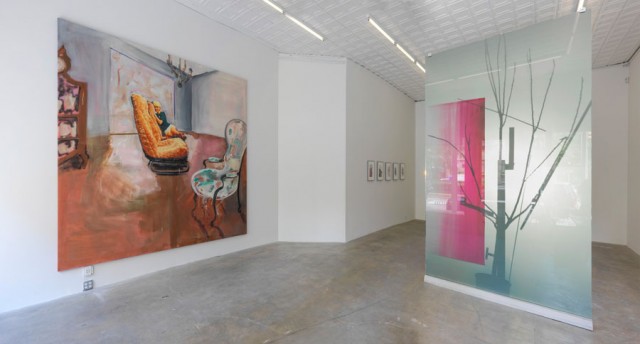
Albert Oehlen’s “‘Home and Garden’ Annex” is on view at Gagosian’s Park & 75 space (photo by Rob McKeever)
Gagosian Gallery, Park & 75
821 Park Ave. at 75th St.
Through September 4, free, 10:00 am – 6:00 pm
www.gagosian.com
German painter Albert Oehlen may be displaying his bravura technique and massive talent in the huge “Home and Garden” exhibition at the New Museum, but his best work in New York City right now is uptown in Gagosian’s glassed-in Park & 75 gallery. On the north wall is “Der rosa Salon” (“The Pink Parlor”), a spectacular painting from a man who continually redefines the genre. The large-scale piece, approximately 110 × 118 inches, was painted over a plastic billboard; in fact, some letters are still visible beneath the paint, primarily the word “NO” in the lower left-hand corner, either accidental or some kind of artistic admonition. Combining reality and surrealism, the painting is anchored by several chairs, one on the right, evoking both Francis Bacon and Franz West while resembling a palette, the others at the center, a pair of comfy tannish-brown chairs, one of which is being fondled by a blond woman in shorts, actually part of an advertisement that Oehlen cut out and pasted onto the plastic base. The empty chair in the middle is like an invitation to the viewer to enter the scene. Oehlen, who lives and works in Switzerland, then painted over the advertisement in such a way as to make it meld into the rest of the imagery, the outline of the cutout visible only if you look for it. A breakfront peeks out on the left, while a lighting fixture dangles from above; below, the floor seems to just drop out. There’s so much going on in the painting that the eye doesn’t know what to focus on, flitting about from woman to furniture, from the light pouring in through a window to the far corner where the walls meet, from the squiggly shadows cast by the legs of the front chair to the big letters “NO” opposite. It’s a dramatic painting in both narrative and execution as fiction and nonfiction clash in appealing ways. Also on view in the gallery are five small collage paintings in which Oehlen incorporates images of trees in addition to the multimedia installation “1000 dances (tree),” in which Oehlen took a living tree, added such elements as Styrofoam, a metal rod, and a poster tube, and placed it behind a floor-to-ceiling translucent sheet that he partially painted pinkish red. A spotlight shines on the back, making a silhouette of the tree visible from the front, which also reflects the activity going on outside on Park Ave. Meanwhile, a lo-fi rah-rah soundtrack plays; the spotlight is supposed to flash in tandem with the music, but a technological malfunction has put an end to that.